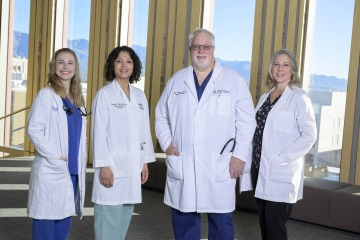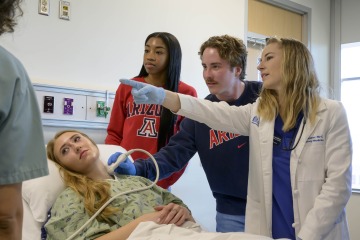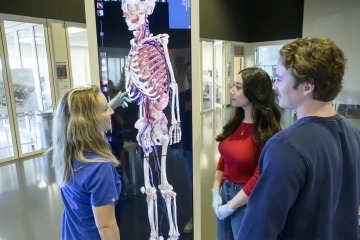Breaking the language barrier to bridge health care gaps
The Physician Assistant program at the College of Health Sciences will teach students medical Spanish to develop more bilingual providers.

The medical Spanish curriculum in the Physician Assistant program is intended to help reduce disparities for Spanish-speaking patients by developing a workforce of compassionate, bilingual providers.
Imagine a person visiting their doctor because they are experiencing swelling in their legs. After examination, the doctor tells the person they have peripheral edema. Without looking it up, will that patient know peripheral edema is a medical term for swelling caused by fluid retention in the legs, ankles and feet? What if the doctor gives that diagnosis in a language the person does not speak?

(From left) Karis Kellner, PA-C, director of clinical education, Salma Patel, MD, medical director, Kevin Lohenry, PhD, interim dean of the College of Health Sciences, and Melanie “MJ” Ellis, MPAS, director of didactic education, are the core faculty members in the Physician Assistant program.
Medical terminology can be hard for some patients to understand. It becomes even more challenging when there is a language barrier between the patient and their medical provider. This simple fact alone can keep many non-English speakers from seeking health care in the United States.
The U.S. Census Bureau reports that nearly 1 in 5 Americans are Hispanic. Of those individuals, about 70% speak Spanish at home. In Arizona, more than 30% of the state’s 7.4 million residents are Hispanic, and more than 26% of all residents report speaking a language other than English in their home. Yet only 6% of physicians in the country speak Spanish, according to the American Association of Medical Colleges.
The University of Arizona Health Sciences is addressing the shortage of Spanish-speaking health care providers through an innovative curriculum path in the College of Health Sciences’ Physician Assistant Program. There, the next generation of physician assistants will take classes in medical Spanish as part their required coursework.
“It makes sense for us to introduce medical Spanish to our students given the demographics of our state and the mission our institution has to serve,” said Kevin Lohenry, PhD, PA-C, interim dean of the College of Health Sciences. “We aspire to see our PAs go out into clinics with a high level of comfort to use a linguistically aligned communication strategy with patients. This makes a huge difference in the patient's ability to be comfortable and for the clinician to have an accurate diagnosis.”
PAs are licensed, board-certified providers who conduct patient interviews, execute comprehensive physical assessments, initiate and decipher diagnostic evaluations, create comprehensive care strategies, and prescribe tailored therapeutic regimens for all patients.
Creating the curriculum
Lohenry and Karis Kellner, MSPAS, PA-C, director of clinical education for the PA program, are developing the curriculum for the PA program, including a medical Spanish requirement. They say few PA programs require students to take medical Spanish courses, which will make the College of Health Sciences’ program unique and attractive to aspiring PAs.

Kellner (right) instructs students learning ultrasound procedures in the Arizona Simulation Technology and Education Center at UArizona Health Sciences.
“We want to minimize the disparities in health care in our community that are related specifically to barriers in communication,” Kellner said. “There are so many patients who need health care but do not seek it because they are afraid they are not going to be understood or that no one is going to speak their language. I hope that fear will begin to go away once our program has an established presence with a constant flow of bilingual PAs to our communities.”
Lohenry and Kellner are collaborating with Santa Arias, PhD, professor and head of the Department of Spanish and Portuguese in the UArizona College of Humanities, to create the medical Spanish courses. Arias says the department plans to have a faculty member dedicated to medical Spanish curriculum, while the College of Health Sciences will identify a clinician who can also help translate the nuances of medical Spanish from a clinical perspective. Medical Spanish courses will be conducted as workshops that include both didactic instruction and clinical practice.
Prior to being admitted to the PA program, students must have taken at least one year of college Spanish. Students can test out of that requirement if they are native speakers or are already proficient in Spanish.
Health care’s human connection
Lohenry’s personal experience serving Spanish-speaking patients has been influential in his desire to include medical Spanish in the PA curriculum. Earlier in his career, Lohenry performed medical mission work in parts of Central America, including Panama. Later, Lohenry worked at a Spanish-speaking family medicine clinic in East Los Angeles.
Though he had some Spanish proficiency, it was not always enough to ascertain the specific conditions or complaints patients had. Lohenry remembers one patient who was struggling with suicidal ideation.
“I knew enough of the language to know that he was depressed and that he was maybe suicidal,” Lohenry said. “The physician who ran the clinic was fluent in Spanish, so I brought him in for a second opinion to get a more consistent linguistic analysis of the patient.”
The physician later confirmed that the patient had a plan to take his own life. It was a valuable lesson for Lohenry on the importance of accuracy when there is a language barrier between patient and provider.
“That was a huge deal for me, because it was about safety and compassion,” Lohenry said. “It’s about the ability to connect with a human who might be going through one of the most difficult moments of their life. A large part of our role as PAs is to find a way to relate to patients that allows them to understand we are there to serve them with compassion and a sincere human-centered interest.”
A language of its own

Kellner (left) believes the medical Spanish curriculum of the PA program will prepare students to provide comprehensive care upon graduation.
Learning medical Spanish can be challenging, even for someone like Kellner, who grew up speaking both Spanish and English. She also minored in Spanish while completing an undergraduate degree at the UArizona Eller College of Management.
Still, Kellner was caught off guard when she first began seeing Spanish-speaking patients as an emergency medicine physician assistant in South Carolina, where only 6% of the state’s population is Hispanic. As one of the few clinicians who could speak Spanish, Kellner was often asked to help care for Spanish-speaking patients in the emergency department. That was when she realized that medical Spanish was essentially its own language.
“Medical Spanish is a training I absolutely wish I had in my clinical upbringing as a PA,” Kellner said. “It was easy to understand if a patient was telling me that their arm hurt or that they twisted their ankle or that they had a headache. But if a patient tried to tell me that their suprapubic catheter was displaced or that their INR was subtherapeutic, I didn’t know those words. If it was a word that I didn’t know by age 10 or one I used in college, I had to look it up.”
Her hope is that students in the College of Health Sciences PA program will be equipped with that understanding before they enter the workforce.
“We want students to have the tools necessary to develop culturally sensitive medical communication strategies with our Spanish-speaking population,” Kellner said. “They should be able to enter the workforce already having a strong vocabulary, confidence and the working knowledge of the Spanish language as it pertains to clinical practice. That will facilitate long-lasting relationships with patients and begin to bridge the gap in health disparities caused by the difference in languages.”
Experts
Kevin Lohenry, PhD, PA-C
Interim Dean, College of Health Sciences
Director, Physician Assistant Program
Assistant Vice President, Interprofessional Education
Karis Kellner, PA-C, CAQ-EM
Director, Clinical Education, Physician Assistant Program
Clinical Instructor, College of Medicine – Tucson
Related Stories
Contact
Blair Willis
UArizona Health Sciences Office of Communications
520-419-2979, bmw23@arizona.edu

